War → Nuclear War → World Nuclear Arsenals
Oh Shit!
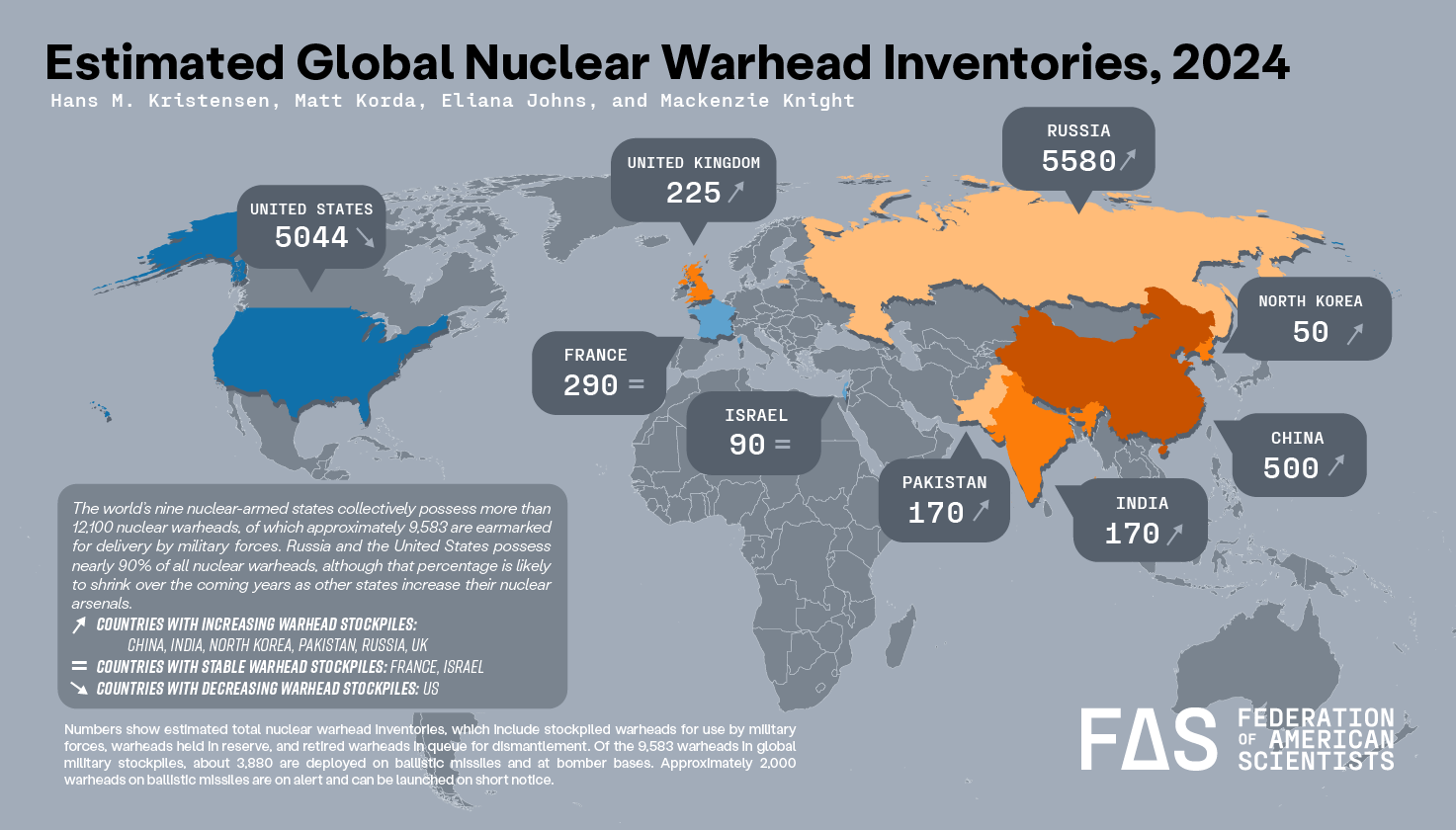
Estimated world nuclear arsenals 2024
Source: Federation of American Scientists
There are 9 countries with nuclear weapons. i.e., USA, Russia, China, France, UK, Pakistan, India, Isreal and North Korea.
Abbreviations, Definitions and Notes
| Delivery Mechanism | Number of Launchers | Warhead Type and Yield in kt | Total Warheads |
| A) Strategic nuclear weapons | |||
| ICBM - LGM-30G Minuteman III | 400 missiles | W78=335kt (MIRV), W87=300kt | 800 |
| SLBM - Trident II | 14 Ohio class subs/280 tubes | W76=90kt (MIRV), W88=455kt (MIRV) | 1,920 |
| Bomber - B-52H Stratofortress | 46 planes | ALCM/W80-1=5-150kt | 500 |
| Bomber - B-2A Spirit | 20 planes | B61=10-400kt | 288 |
| Subtotal strategic | 3,508 | ||
| B) Non-Strategic nuclear weapons | |||
| Various (F-15, F-16, F-35) | Not known! | B61=0.3-170kt | 200 |
| TOTAL warheads | 3,708 | ||
| For more detail see: https://thebulletin.org/premium/2024-05/united-states-nuclear-weapons-2024/ |
The bulk of the USA nuclear arsenal (1,920 warheads) is allocated to strategic offensive delivery and is SLBM MIRV based ie., submarine launched Trident II missiles with up to 12 independently targetable warheads, each with a maximum declared yield per warhead of 455/475 kilotons.
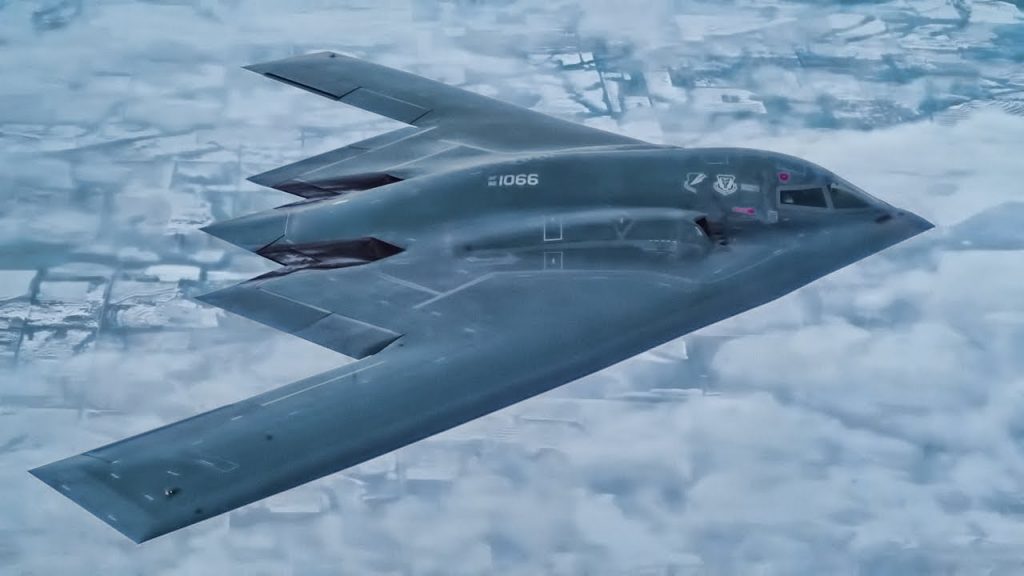
B-2 Spirit nuclear bomber in flight 2019
Source: Military Aviation Review. See: https://militaryaviationreview.com/video-509th-bomb-wing-b-2a-spirit-in-flight-2019
Russia
Russia has a declaired total inventory of 5,580 nuclear warheads (2024). The active stockpile is 4,380 of which 1,710 are actively deployed and 2,670 warheads held in reserve. The inventory total of 5,580 warheads also includes 1,200 warheads that are designated as retired, awaiting dismantlement.
The alllocation of the active stockpile to delivery mechanisms is shown below:
| Delivery | Number of Launchers | Warheads and Yield in kt | Total Warheads |
| A) Strategic nuclear weapons | |||
| ICBM - RS20v (Voevoda) | 34 | 10x500-800kt (MIRV) | 340 |
| ICBM - ? (Avangard) | 10 | ? | 10 |
| ICBM - Mobile+Silo RS-12 (Topol-M) | 78 | 1x800kt | 78 |
| ICBM - Mobile+Silo RS-24 (Yars) | 204 | 4x100kt? (MIRV) | 816 |
| SLBM - RSM-54 (Sineva/Layner) | 5 subs/80 tubes | 4x100kt (MIRV) | 320 |
| SLBM - RSM-56 (Bulava) | 7 subs/112 tubes | 6x100kt (MIVR) | 672 |
| Bomber - TU-95 | 52 | 6-14xALCM | 430 |
| Bomber - TU-160 | 15 | 12xALCM | 156 |
| Subtotal strategic | 2,822 | ||
| B) Non-Strategic/Defencive nuclear weapons | |||
| Various (Tu-22, MIG-31 etc.) | Not known! | 1xlow-350kt | 1,558 |
| TOTAL warheads | 4,380 | ||
| For more detail see: https://thebulletin.org/wp-content/uploads/2024/03/rbul_a_2314437_t0001.pdf |
Russia has 2,822 warheads allocated to strategic offensive delivery mechanisms (ICBM, SLBM and Bombers) and 1,558 warheads allocated to non-strategic battlefield and "defensive" delivery, such as fighter jets, ground launced cruise missiles (GLCM), short range surface to surface and surface to air missiles (SSMs and SAMs) etc. Although having a larger total stockpile than the USA, allocation between strategic and non-strategic usage differs markedly. The USA arsenal is more focused on strategic offensive weapons (3,508 compared to Russia's 2,822) with little emphasis on non-strategic warheads, of which there are only 200 in the USA arsenal. Interestingly however, the number od warheads actually deployed by the USA and Russia is almost the same (USA 1,770 - Russia 1,710).
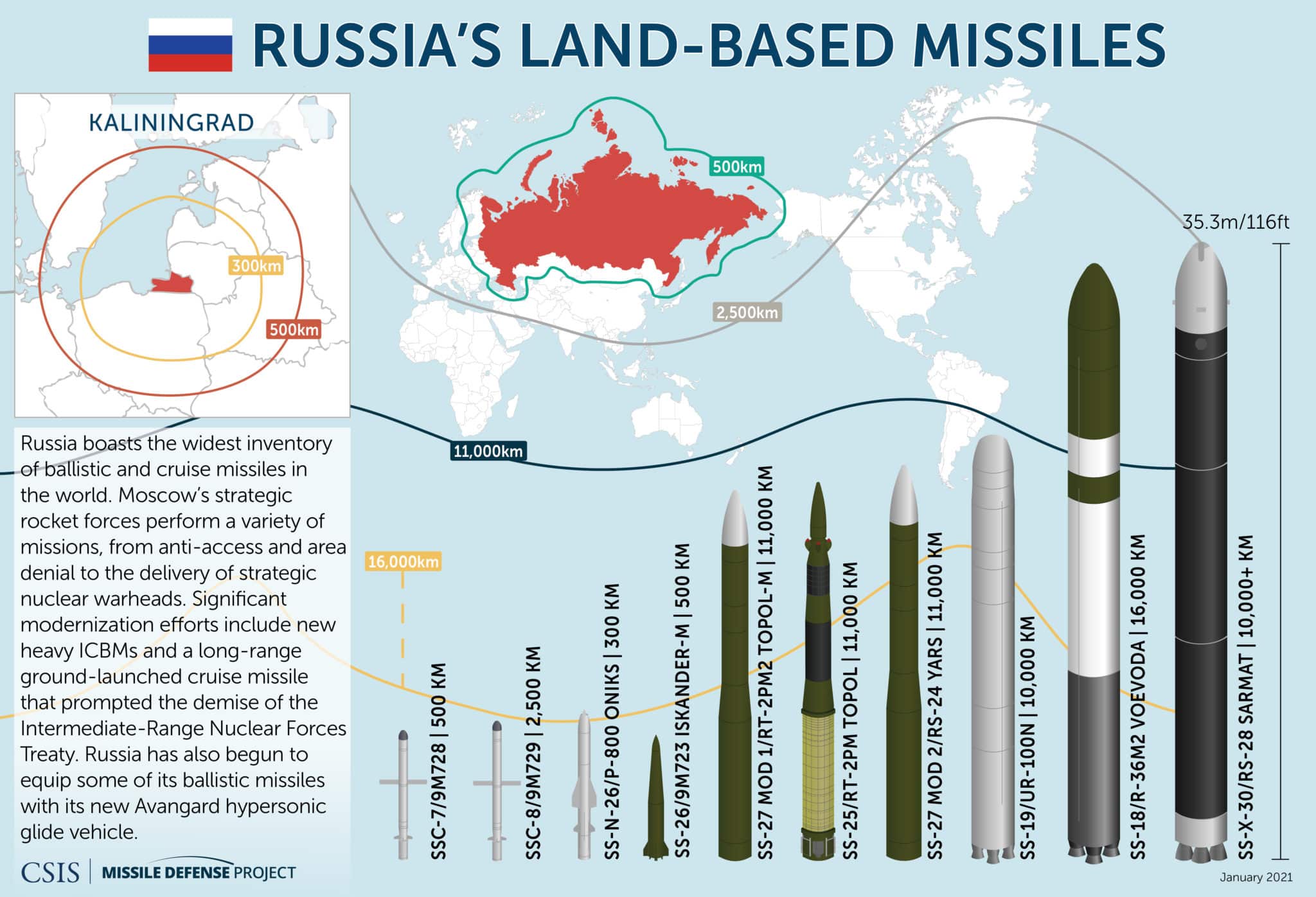
Russia's land-based missiles
Source: Missile Threat, CSIS Missile Defence Project. See: https://missilethreat.csis.org/country/russia/
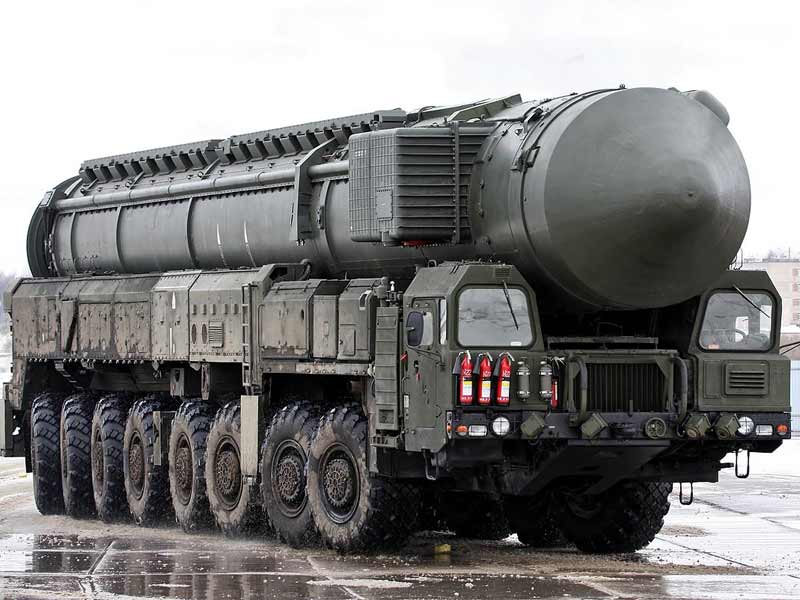
RS-24 Yars mobile nuclear ICBM MIRV range 12,000 km
Source: Shootinfo.com. See: https://shootinfo.com/top-10-best-intercontinental-ballistic-missiles-in-the-world/
China
China is thought to have around 500 nuclear warheads, ranging in yield from 200 kilotons to a massive 5 megatons.
| Delivery Mechanism | Number of Launchers | Warhead Type and Yield in kt | Total Warheads |
| A) Land-based ballistic missiles | |||
| MRBM - DF-26 (Range 4,000 km) | 216 | 1x200-300 kt | 108 |
| ICBM - DF-5A (Range 12,000 km) | 6 | 1x4,000-5,000 kt | 6 |
| ICBM - DF-5B (Range 13,000 km) | 12 | 5x200-300 kt (MIRV) | 60 |
| ICBM - DF-31A (Range 11,200 km) | 24 | 1x200-300 kt | 24 |
| ICBM - DF-31AG (Range 11,200 km) | 64 | 1x200-300 kt | 64 |
| ICBM - DF-41 (Range 12,000 km) | 28 | 3x200-300 kt (MIRV) | 84 |
| Subtotal land-based missiles (silo + mobile) | 346 | ||
| B) Submarine-based ballistic missiles | |||
| SLBM - JL-3 (Range 9,000+ km) | 6 subs/72 tubes | ? 1x200-300 kt | 72 |
| C) Fighters/Bombers | |||
| H-6K | 10 | ? 1xbomb | 10 |
| H-6N | 10 | ? 1xALCM | 10 |
| H-20 (New Stealth bomber) | ? | ? bomb/ALCM | ? |
| TOTAL warheads | 438 + ?62 = 500 | ||
| For more detail see: https://thebulletin.org/wp-content/uploads/2024/01/rbul_a_2295206_t0001_withnotes.pdf |
Of all the nuclear powers, China is probably the most aggresive in its development of both new ballistic missiles and new warheads,
and is also actively developing
advanced multiple independently targetable reentry vehicles (MIRVs). It also has a very active missile silo building programme.
There is much
uncertainty as to the actual number of operational warheads China deploys but its active missile development programmes suggests more than the 438 warheads
that can be accounted for. It is generally agreed that 500 is probably closer to the mark. Note, all of China's ICBMs can target all of Europe,
the UK and the USA.
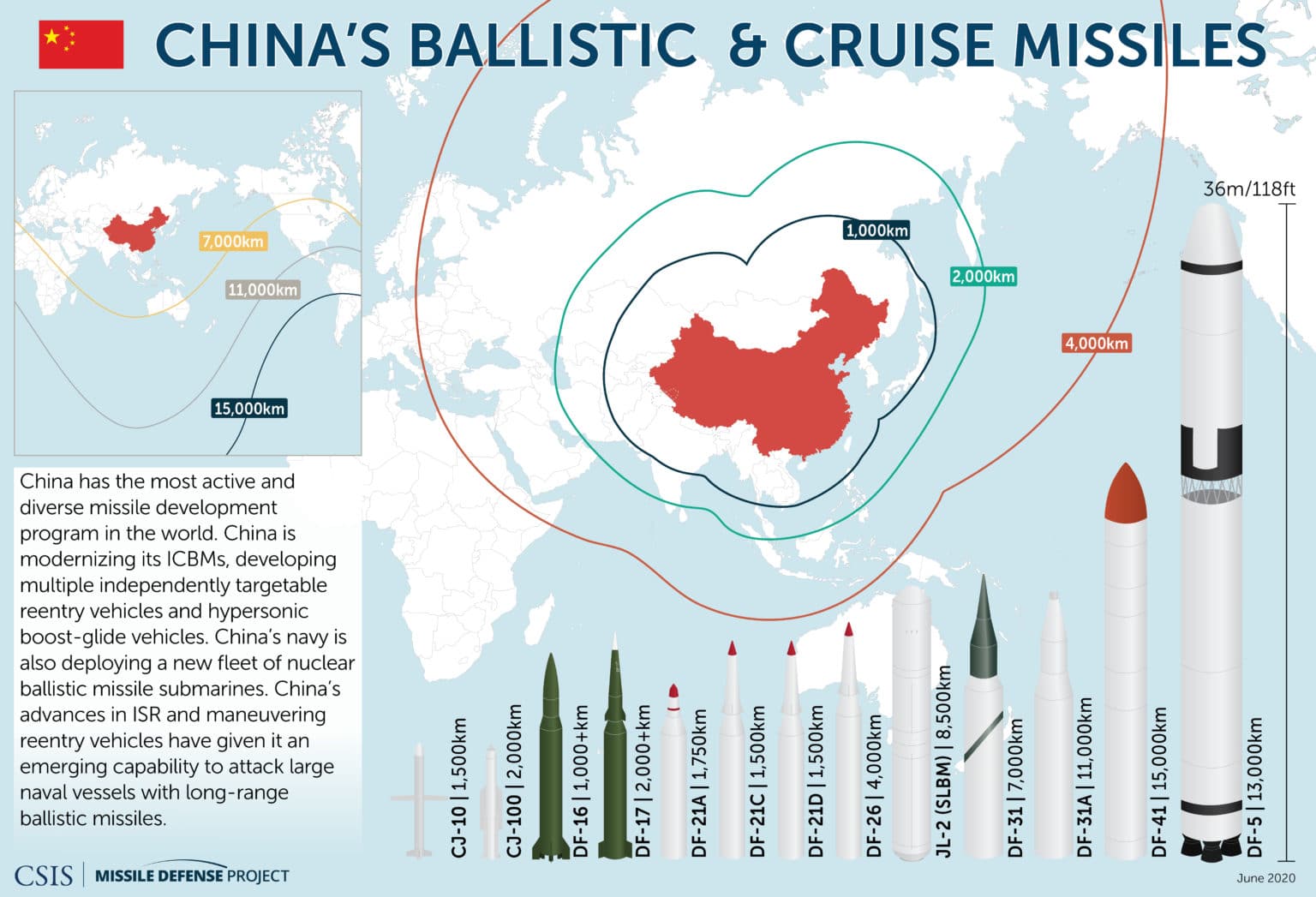
China's ballistic and cruise missiles
Source: Missile Threat, CSIS Missile Defence Project. See: https://missilethreat.csis.org/country/china/
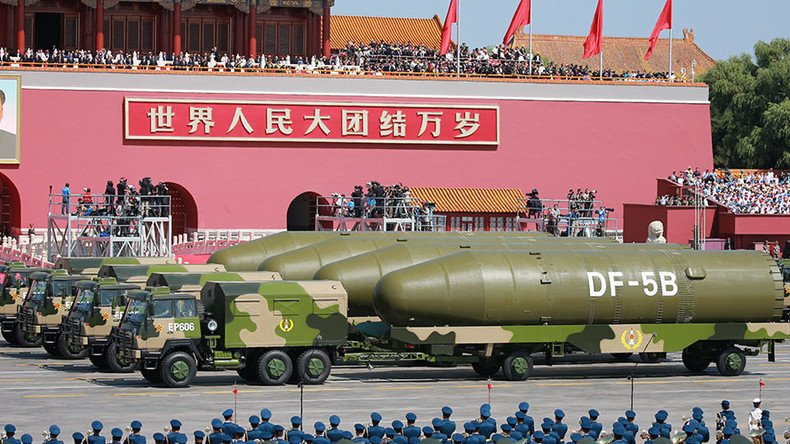
Dongfeng (DF-5B) ICBM MIRV missile, range 13,000 km
Source: RT.com. See: https://www.rt.com/news/375962-china-mirv-missile-test/
France
France holds 290 nuclear warheads. All are operational and can be deployed at short notice.
| Delivery Mechanism | Number of Launchers | Warhead Type and Yield in kt | Total Warheads |
| Land Based Aircraft - Rafale BF3 | 40 | 1x less than 300 kt | 40 |
| Carrier Based Aircraft - Rafale MF3 | 10 | 1x less than 300 kt | 10 |
| SLBM - M51.1 | 16 | 4-6x100 kt (MIRV) | 80 |
| SLBM - M51.2 | 32 | 4-6x100 kt (MIRV) | 160 |
| TOTAL warheads | 290 | ||
| For more detail see: https://thebulletin.org/premium/2023-07/nuclear-notebook-french-nuclear-weapons-2023/ |
The strength of France's nuclear deterent lies in its number of continuously at sea submarine-launched ballistic missiles (SLBMs). It operates 4 Triomphant class nuclear submarines, based at the Ile Longue naval base near Brest in Brittany, with one always on patrol, one preparing for patrol, one returning to port and one in maintenance. The primary missile is the 3 stage M51. The M51.1 has a range of over 6.000 km and can carry up to 6 independently targeted MIRV TN75 warheads. The M51.2 has a range of 9,000 km and carries the upgraded TNO MIRV warhead. The M51 missile is undergoing continuous upgrade. The M51.3 began development in 2014 and a future M51.4 is also planned. A new, more advanced nuclear submarine, is also planned (the SNLE-3G) to replace the current Triomphant class begining 2035.
France also operates air launched nuclear tipped cruise missiles via its Rafale fighter bombers, both land based and sea based (on its only aircraft carrier, Charles de Gaulle).
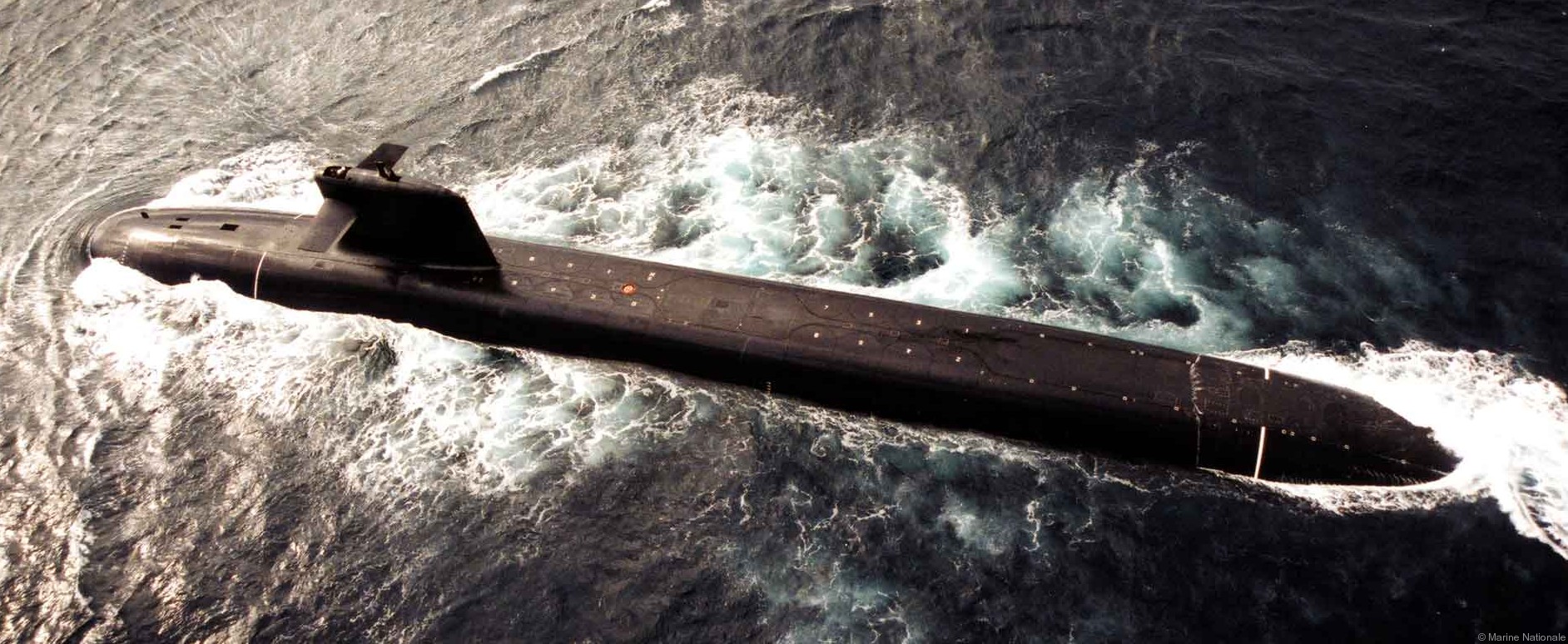
French Le Triomphant class ballistic missile submarine
Source: Seaforces - online. See: https://www.seaforces.org/marint/French-Navy/Submarine/Le-Triomphant-class.htm
UK
The UK is unique amongst the nuclear powers in having only a single delivery system for its nuclear deterent, i.e., by nuclear-powered ballistic missile submarines (SSBNs). The UK has a total stockpile of around 225 warheads of which 120 are operationally available at all times. It operates 4 Vanguard class nuclear submarines each carrying 16 Trident II D5 missile launch tubes and 40 warheads. Each Trident missle (the same missile deployed in th US Ohio class nuclear submarines) can be loaded with 1 to 8 independently targetable warheads (MIRVs) of 100 kt yield each. One submarine is on patrol continuously in what is called Continuous At-Sea Deterrent (CASD) posture, two submarines remain in port and can be deployed at short notice while the fourth is undergoing maintanence.
Recently, the UK announced that it would be increasing its nuclear stockpile to 260 to counter the growing threat from Russia. It has also announced a new series of advanced nuclear submarines, the Dreadnought Class, to enter service in the early 2030's, which will be equiped with the advanced 3 Quad Pack common missile compartments being designed in cooperation with the US Navy. Each Quad Pack will contain 4 launch tubes for a total of 12 launch tubes per submarine. The UK is also upgrading its warheads, from the current "Holbrook" (a variant of the American W-76 thermo-nuclear warhead) to a newer version of the American W93.
The closeness of the UK nuclear SSBNs and warheads to that of the USA should not go un-noted.
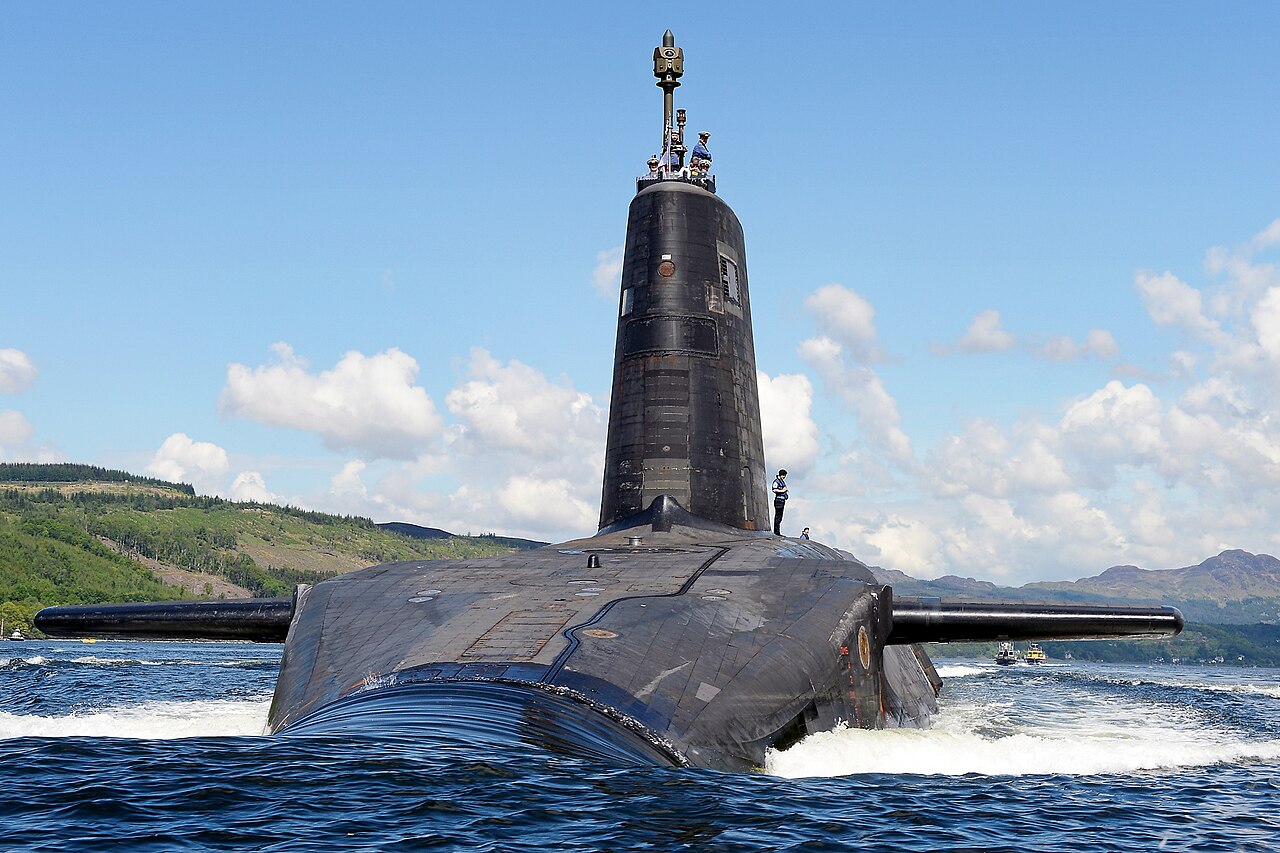
Royal Navy submarine HMS Victorious - a Trident missile-armed Vanguard-class submarine
Source: Wikipedia. See: https://en.wikipedia.org/wiki/Trident_(UK_nuclear_programme)#/media/File:HMS_Victorious_MOD_45155638.jpg
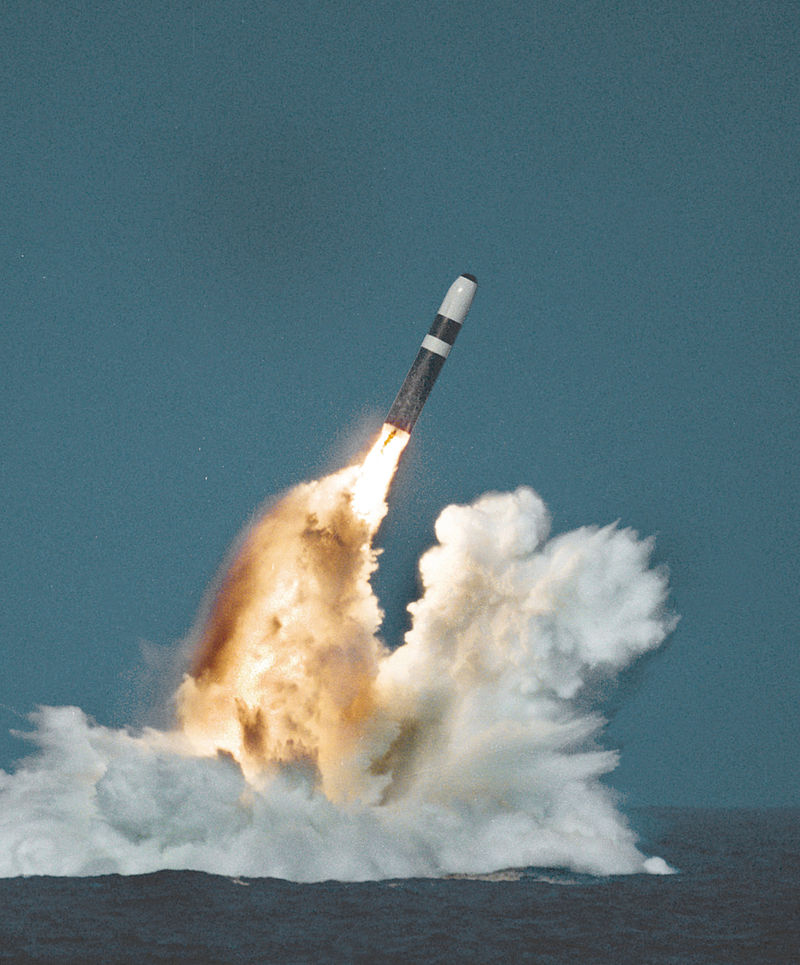
Test launch of a Trident II missile by a Vanguard-class submarine
Source: Wikipedia. See: https://en.wikipedia.org/wiki/Vanguard-class_submarine#/media/File:Trident_II_missile_image.jpg
India
India is highly secretive regarding it nuclear ambitions and little information is publicaly available on its nuclear capabilities and stockpile. It is estimated, however, that India has around 160 to 170 nuclear fission based warheads with yields in the range of 10 to 40 kt. There is currently no evidence to suggest that India has two-stage thermonuclear warheads.
Delivery mechanisms include fighter/bomber aircraft (Mirage, Jaguar and Rafale) each of which may be adapted to deliver a nuclear tipped cruise missile. It is most likely that the recent purchase of the Rafale jet from France will now form the backbone India's nuclear strike capability. India also possesses a range of land-based short to medium range ballistic missiles (notably the Prithvi and Agni) again, each of which is capable of carrying a single nuclear warhead. The nuclear capable Agni-V has a range of 5,000 km and Agni-VI a range of up to 6,000+ km. India also has and is developing a range of sea-based misiles, the Dhanush (ship based with a range of around 400 km), the K-15 and K-4 (both submarine launched missiles). The newest of these missiles, the K-4, will have a range of up to 3,500 km. The K-15 and K-4 missiles will also form the backbone of India's developing series of nuclear powered ballistic missile submarines (SSBNs).
Nuclear Policy - India claims a "no-first-use" policy but statements by government officials often contradict this stance. The development of India's nuclear capability has obviously been driven to a large extent by its shakey relationship and often open hostility shown with its also nuclear capable neighbour, Pakistan. This open hostility must therefore constitute one of the most concerning nuclear first use hot spots on the planet. India's deteriating relationship with China, a major nuclear power, will, no doubt, also spur India on to develop or acquire more advanced and longer range nuclear weapons.
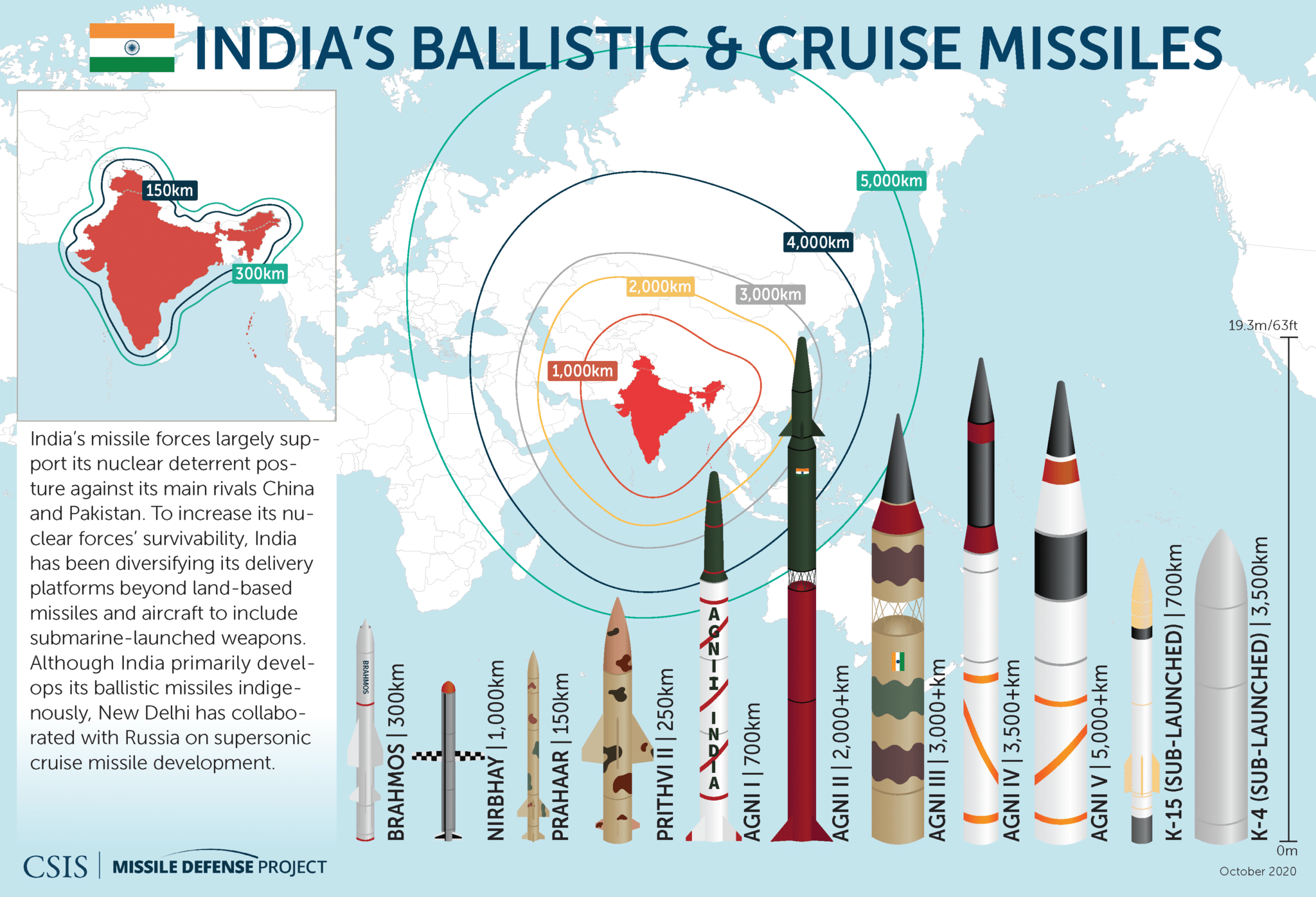
Indias ballistic and cruise missiles
Source: Missile Threat, CSIS Missile Defence Project. See: https://missilethreat.csis.org/country/india/
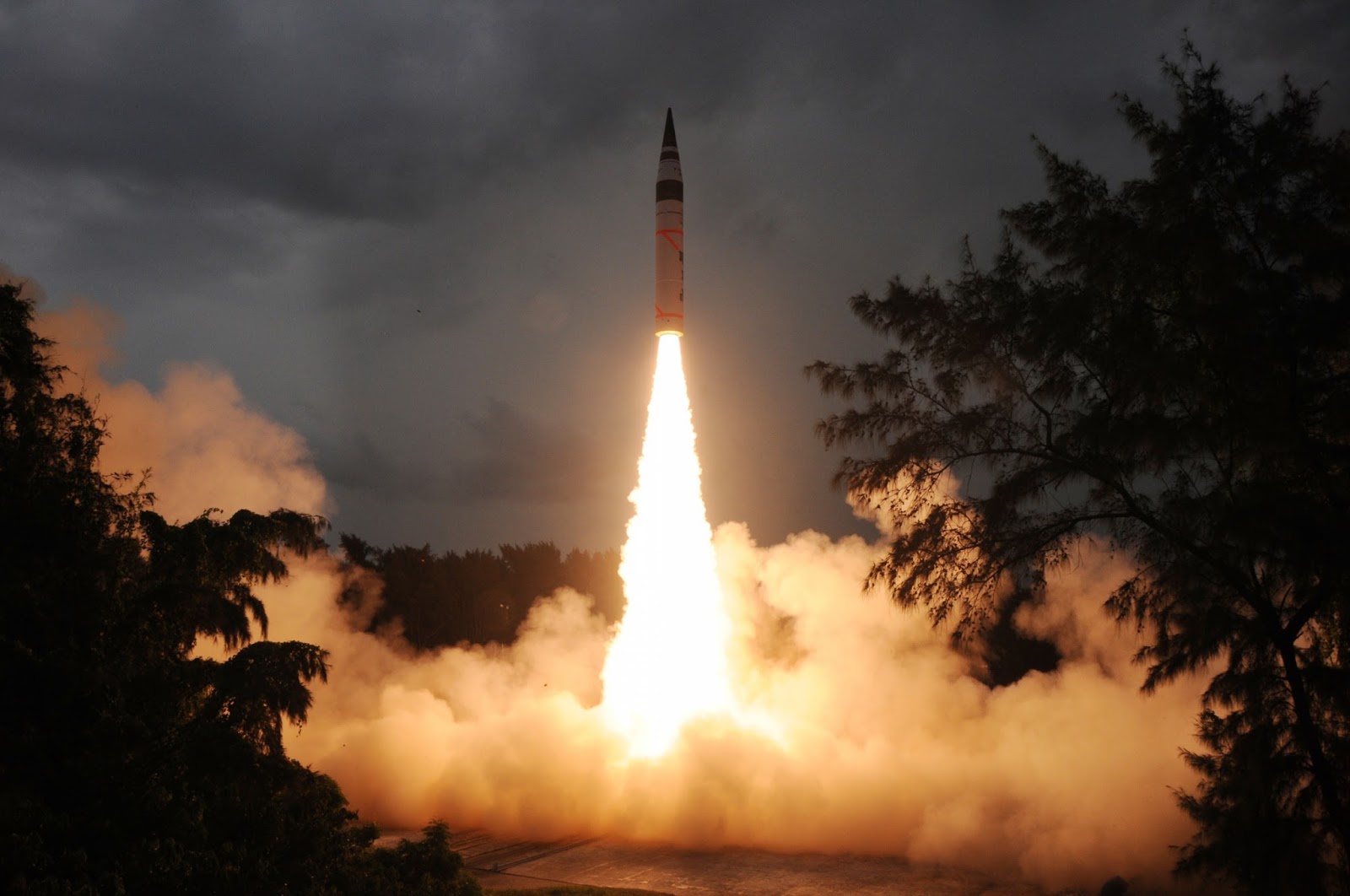
India successfully tests its Agni-V intercontinental ballistic missile, range 5,000 km
Source: The Bharat Military Review. See: https://thebharatmilitaryreview.blogspot.com/2013/09/india-successfully-tests-agni-v.html
Pakistan
Pakistan is estimated to have a stockpile of around 170 nuclear warheads. It also has an active development programme for new delivery systems, particularly missiles, and an expanding uranium enrichment infrastructure. As a result its stockpile is expected to grow significantly over the coming years.
Pakistan sees India as it main adversary/security threat, and it is this threat and India's vastly superior military that has accelerated Pakistan nuclear development programme particularly in the field of low-yield non-strategic tactial nuclear capabilities. It belives that its emphasis on battlefield and defensive nuclear weapons may have been protecting it from Indian aggression and incursions since the 1980's.
Most of Pakistan's ballistic and cruise missiles are dual capable (i.e, can carry both convention or nuclear warheads). One of its newest missiles, the Shaheen III, has a range of 2,750 km and could target all of mainland India. In 2017 Pakistan also tested a new medium range solid fuel ballistic missile, the Ababeel, that they claim is capable of carrying multiple nuclear warheads (MIRV). Pakistan's nuclear warheads are dominanly fission or boosted fission type weapons with yields in the range of 5 to 12 kt or 10 to 40 kilotons.
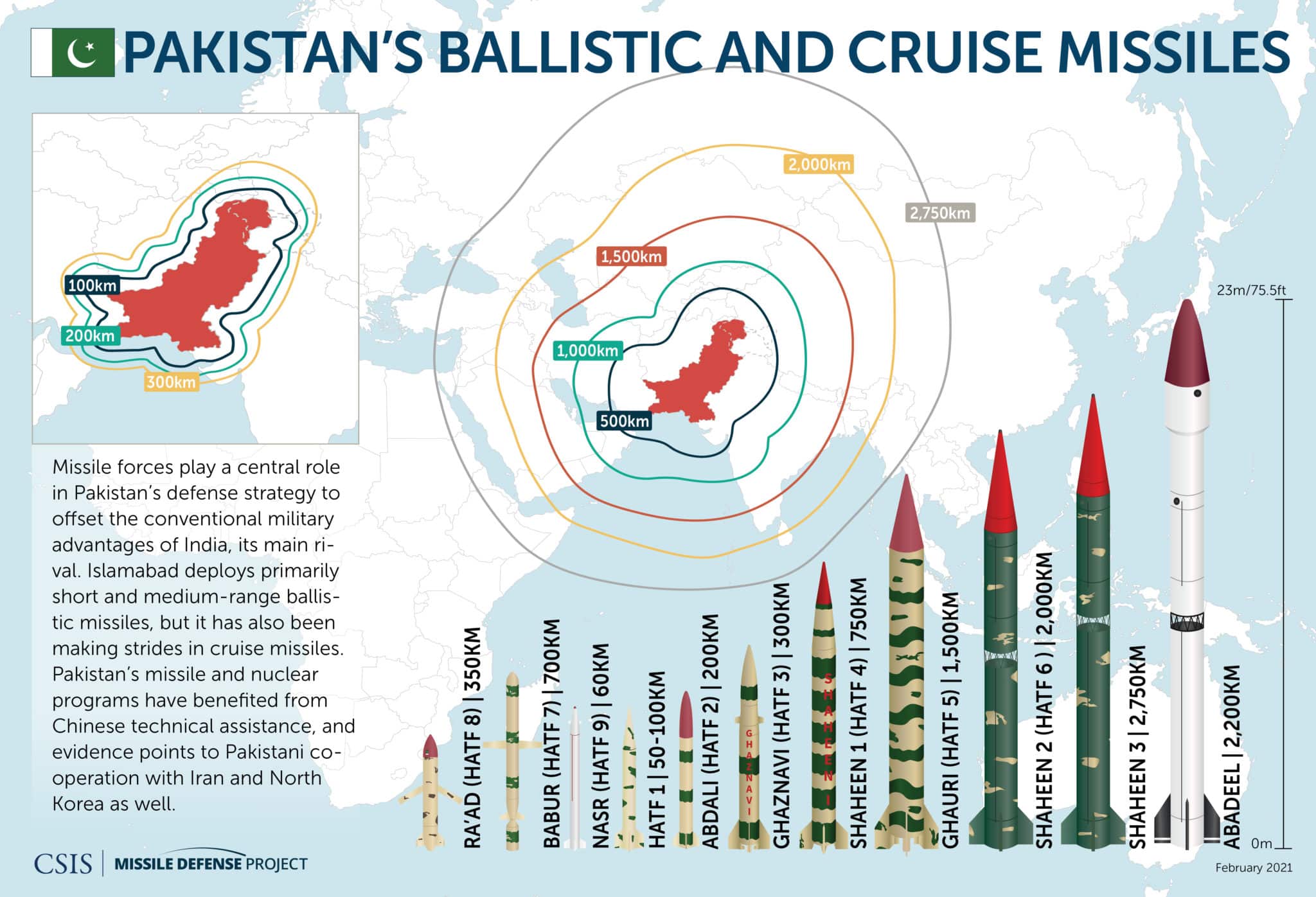
Pakistan's ballistic and cruise missiles
Source: Missile Threat, CSIS Missile Defence Project. See: https://missilethreat.csis.org/country/pakistan/
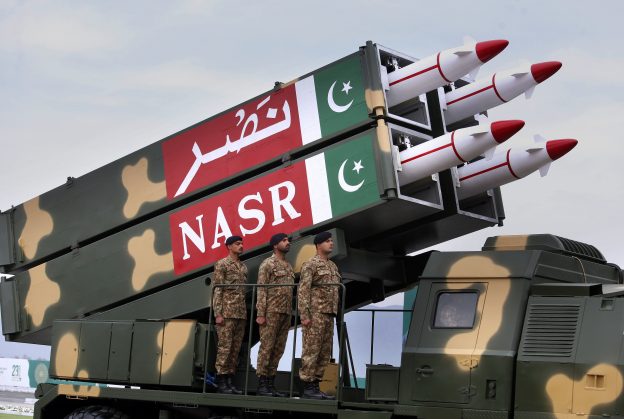
Pakistan's short range nuclear capable NSAR ballistic missile
Source: The Diplomat. See: https://thediplomat.com/2020/03/the-china-pakistan-nuclear-nexus-how-can-india-respond/
Israel
Israel is believed to have between 60 to 90 nuclear warheads although it will not officially confirm whether it has nuclear weapons/warheads or not. It is known, however to possess a plutonium
seperation/enrichment facility (the Negev Nuclear Research Center near Dimona) and most estimates of
Israel's potential nuclear stockpile are based on the amount of plutonium that may have been produced from this facility (around 900 to +1,000 kilograms).
It also has potential nuclear delivery
mechanisms, specifically F-16, F-15 and F-35 jets from the USA, a short to medium range (1,500 km) missile the Jericho II
and a recently developed 3 stage intermediate range (4,000 km to 5,000 km) balistic missile (IRBM) the Jericho III. Bunkers are also known to exist
at Sdot Micha to house these missiles. Israel is also known to posses 3 German Dolphin II class submarines, with specifically designed 650 mm tubes ,capable
of housing the nuclear capable "Popeye Turbo" submarine launched air to surface cruise missile (SLCM) with a range of around 1,500 km.
The relative
sopistication of the Israel nuclear stockpile is also unknow. It will probably have pure fission weapons and possibly boosted fission weapons (because of the
know manufacture of lthium-deuteride hemispherical shells at Dimona) but whether the country has the knowledge or facility to build two stage
thermo-nuclear warheads is still unknown.
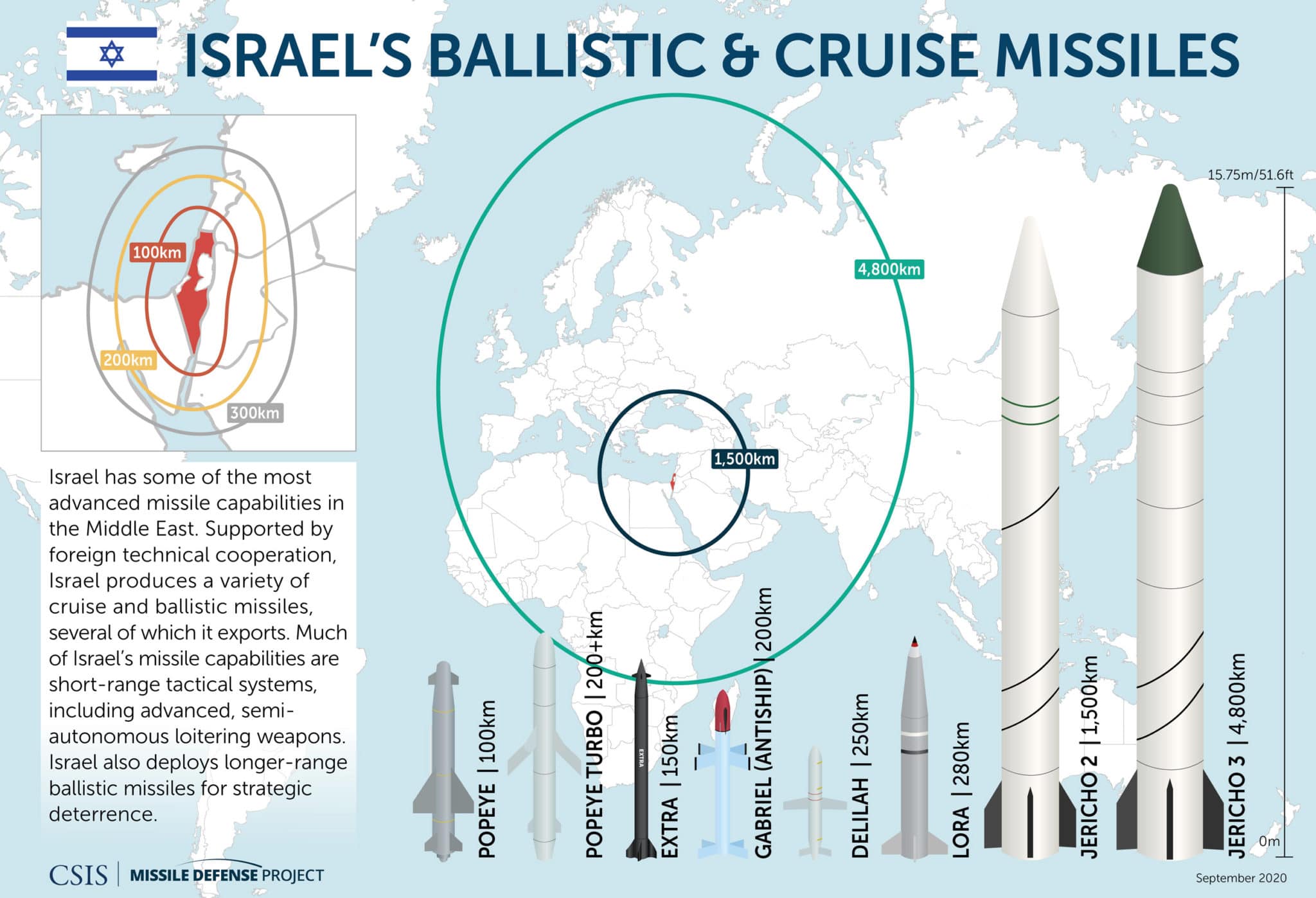
Israel's ballistic and cruise missiles
Source: Missile Threat, CSIS Missile Defence Project. See: https://missilethreat.csis.org/wp-content/uploads/2020/09/Israel_Missiles_web-1.jpg

Test firing of Israel Jericho III intermediate range ballistic missile (IRBM), range 4,800 km, payload 1,000 to 1,300 kg
Source: Global Military Review. See: https://globalmilitaryreview.blogspot.com/2011/11/israel-tests-jericho-series-ballistic.html
North Korea
Again a country who's nuclear warhead programme is poorly known, but North Korea is thought to have produced sufficient fissile material to build 45 to 55 nuclear weapons and might have assembled 20 to 30 warheads. It has undertaken six underground nuclear test explosions, generally of small yield (less than 10 kt), but the last test in September 2017 was estimated to have a yield in excess of 100 kilotons. This might indicate that North Korea has already developed or is close to developing a thermo-nuclear warhead.
North Korea also operates a very aggressive missile development programme. It has a large arsenal of short to medium range balistic missiles several of which are assumed to be nuclear capable, and can easily threaten South Korea, but it is unclear whether it has yet developed a long range intercontinental ballistic missile with a functioning nuclear re-entry vehicle capable of threatening regional targets such as Japan or the USA. Its latest ICBMs are the Hwasong 14, 15 and 17 with a "declaired" range of between 10,000 to 13,000+ km but whether these missiles are performance robust, or currently nuclear capable, is unknown.
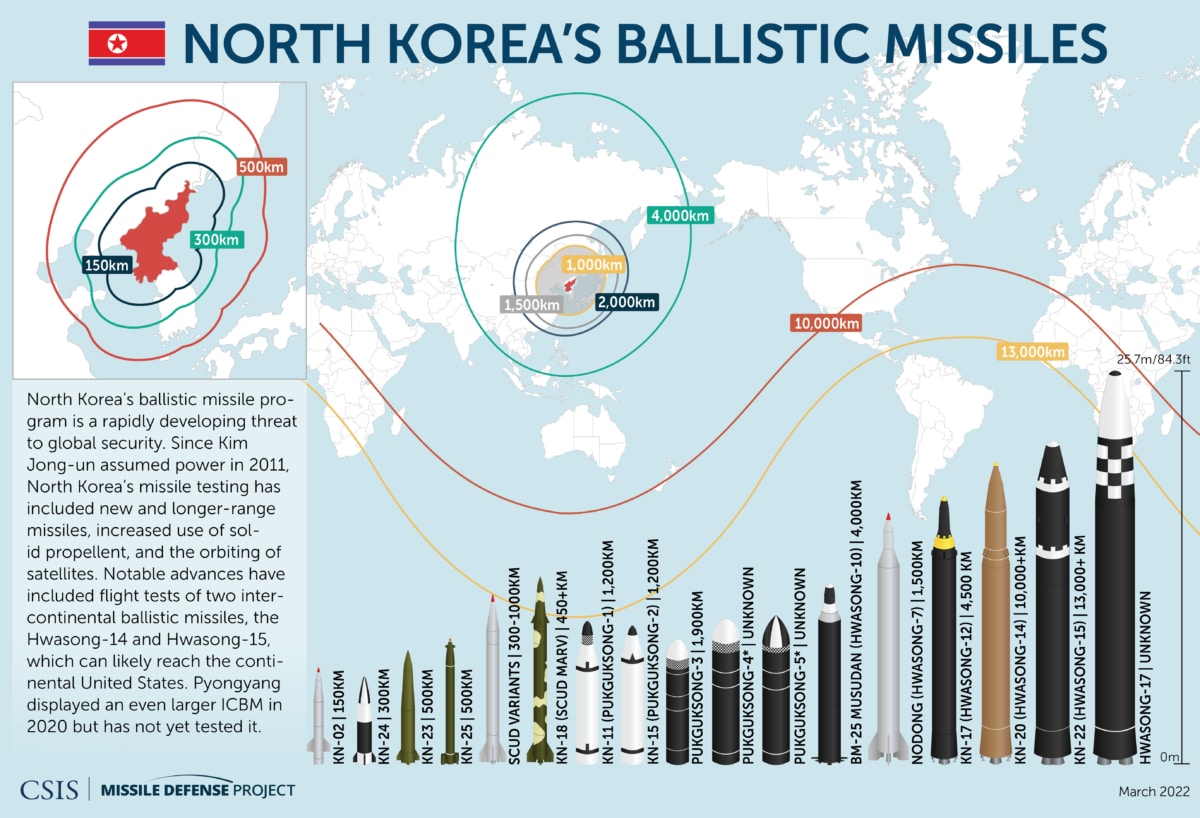
North Korea's ballistic missiles
Source: Missile Threat, CSIS Missile Defence Project. See: https://missilethreat.csis.org/country/dprk/
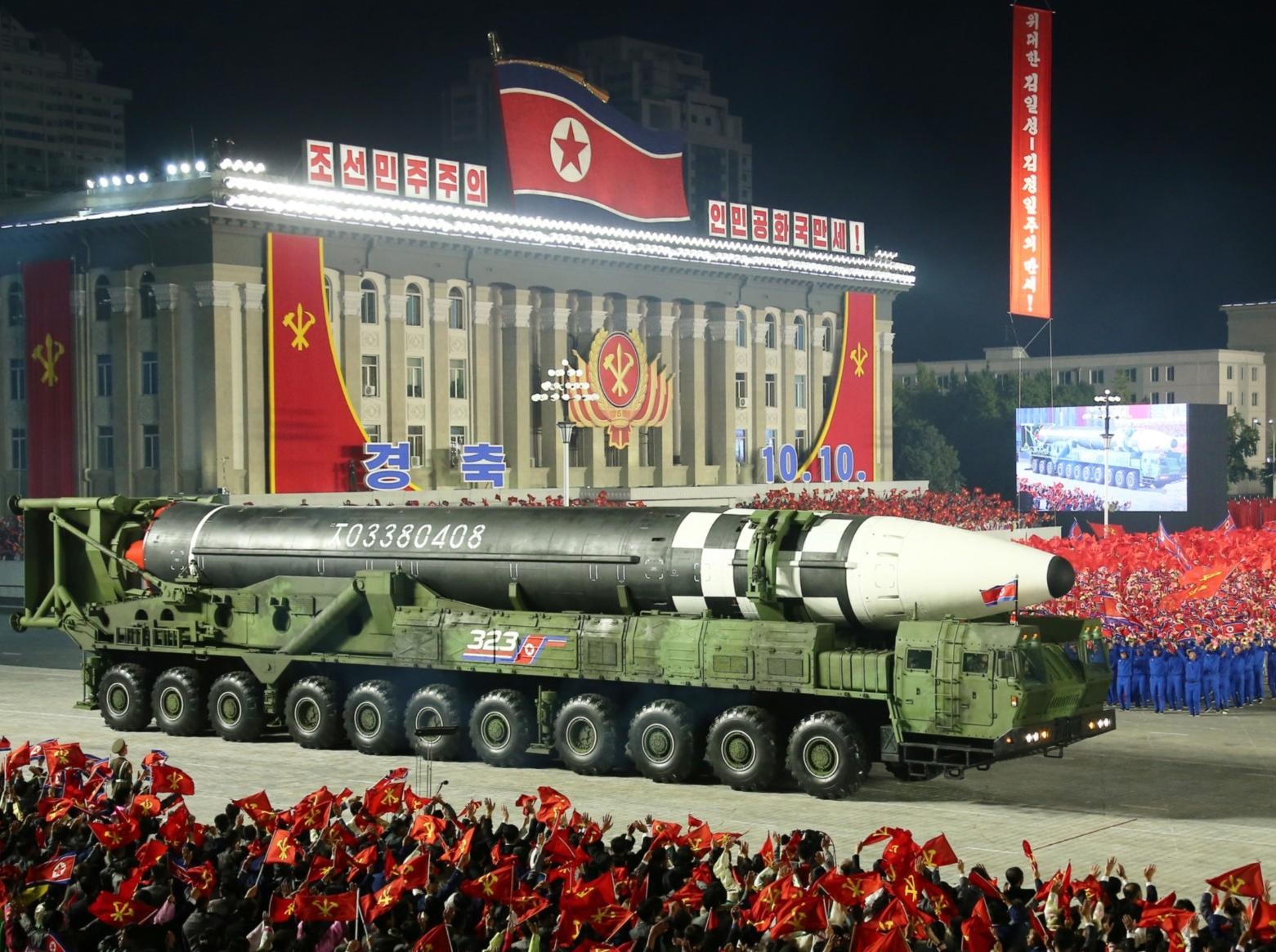
North Koreas most recent ICBM, the Hwasong 17
Source: RAND See: https://www.rand.org/pubs/perspectives/PEA1015-1.html